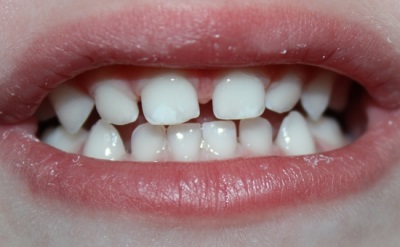Fluoridation of teeth in children
Milk teeth are quite fragile and vulnerable, so caries occurs in almost 70% of children under 6 years of age. Doctors have developed many methods of treatment of this disease at an early stage, as well as its prevention. One of the most popular these days is fluoridation.
What is it?
So called the process of dental treatment with preparations containing fluoride. From the composition applied to the enamel, fluoride ions are released and begin to contact with the tooth tissues with the formation of calcium fluoride crystals, which strengthens the tooth enamel and stops its destruction from caries.
pros
- Fluoridation is able to protect the baby’s milk and permanent teeth from early caries.
- The procedure is easy to perform and does not cause any discomfort for the child, so it can be carried out at a very early age.
- It differs from silvering in that the teeth do not darken, but remain white.
- Due to the fluoridation, the strength of the tooth enamel increases, and if its sensitivity is increased, the procedure eliminates this problem.
- When processing fillings, fluoridation helps to prolong their service life in children.
Minuses
- The procedure should be repeated regularly.
- Excess fluorine in the children's body from a poor-quality drug is fraught with poisoning.
- Manipulation will not help with severe caries.
For details on fluoridation of milk teeth, see the video:
Indications
The child is advised to perform teeth fluoridation with:
- Detection of the first signs of caries at the initial stage (white spots on the teeth).
- Increased tooth sensitivity to external influences.
- The lack of fluoride in the child’s drinking water and food.
- The need to protect the teeth, which are installed braces.
- The desire to extend the life of the fillings on the tooth.

Contraindications
Fluoridation is not recommended in the case of:
- Increased levels of fluoride in water and food, which the child consumes, as well as the development of fluorosis.
- Individual intolerance to the components used in the procedure of the solution.
- The development of medium or deep caries, when the infection turned to dentin.
Stages of fluoridation
The first stage of treatment will be the removal of plaque from the teeth. Further, simple fluorination can be performed by two methods:
- Using special capswhich the dentist creates individually based on the baby’s tooth casts. A preparation containing fluorine is introduced into the cap, after which the device is put on the teeth and left for 10-15 minutes. Manipulation is repeated 10-15 times.
- By applying fluorolac to tooth enamelwhich is dried by a lamp. This procedure is repeated every six months.
Deep fluoridation
In contrast to simple fluoridation, in which preparations are used with rather large fluorine molecules that do not penetrate into the enamel, but remain on its surface, there is also deep fluoridation.
The result of its implementation will be the formation in the tissues of the tooth of submicroscopic crystals that persist for several years in the tooth enamel. From these crystals, fluoride ions will be released in the tooth tissue for a long time, causing them to be remineralization.
Deep fluoridation includes the following steps:
- Cleaning the surface of the teeth and the gaps between them from plaque.
- Drying teeth.
- Treatment of teeth with a composition containing calcium and magnesium fluorides.
- The second drying of the teeth.
- Treatment of teeth with a composition in which calcium hydroxide is present.
How old is the procedure?
You can perform simple fluoridation from the moment when the first teeth appear in the child. As for deep fluoridation, the procedure is performed for children older than 1.5-2 years.
In the absence of contraindications, manipulation is recommended for all children, because after teething for several years mineralization processes occur in its enamel, and the treatment procedure with fluoride preparations will increase their activity.
Reviews
Parents are more positive about fluoridation than about silvering. Most of those who have carried out such treatment of the teeth of their children, note that this is a fairly effective procedure. Among the advantages note the speed of manipulation and its painlessness. The disadvantages include the need to go to the processing several times. Also, some parents point out the dubious benefits of fluoridation, since such a procedure did not protect the teeth of their babies.
Opinion Komarovsky
Famous pediatrician focuses on the fact that fluoridation does not cure caries, but acts only as a prophylactic method, helping to wait for the physiological change of teeth without removing the diseased tooth and harming the bite.
If the caries of the child has penetrated deeper than the surface tissues, Komarovsky advises to abandon fluoridation and resort to more effective treatment - filling.
As regards prophylactic agents with fluoride, the popular doctor advises brush your teeth with fluoride toothpastedesigned for children. If the parents decide to resort to fluoridation, Komarovsky does not recommend performing this procedure using fluoride, as he considers such an inexpensive drug ineffective, since it is quickly washed off from the child’s teeth.
The release of Dr. Komarovsky’s program on children's teeth, see below:
Home fluoridation
Strengthen teeth with fluoride on their own using various tools that contain this element. They are presented:
- Toothpaste. This is the most common option for home strengthening teeth with the use of fluoride. Their components are various fluoride compounds that can eliminate minor defects of the enamel and prevent caries.
- Gels. Before using them, the teeth are thoroughly cleaned of plaque and saliva, then gel is applied to the teeth for 3-4 minutes, repeating the courses of the procedure several times a year. Examples of fluorine-containing gels are the drug Fluodent and Fluocal.
- Rinsing. When applying them, it is important to ensure that the child does not swallow the solution, so these means are most often used after the eruption of the first permanent teeth.
- Pills. If there is a shortage of fluoride in food and water, the doctor will recommend sodium fluoride tablets that can be given to children from the age of two.
Prevention
To prevent children's tooth decay from caries and the need to use fluoride-containing protective drugs, it is important:
- Expectant mother during the pregnancy to monitor their diet and health, in order not to harm the crumbs in the period of their intrauterine insertion.
- Carefully monitor baby’s oral hygiene, starting to brush the baby's teeth as soon as they are cut.
- Do not lick either a pacifier or a spoonful of a child.
- Do not bottle feed at night or give sweet drink at night. after the appearance of the first milk teeth.
- Limit sweets in the baby's diet and try to give them in the first half of the day.
- Do not include carbonated sugary drinks, candies and toffee in the diet of the baby.
- If the child drinks sour juice, give crumbs a straw.
- Monitor immunity karapuza, strengthening it.
- Regularly go with the baby to the dentist, in time to identify problems with milk teeth.

















